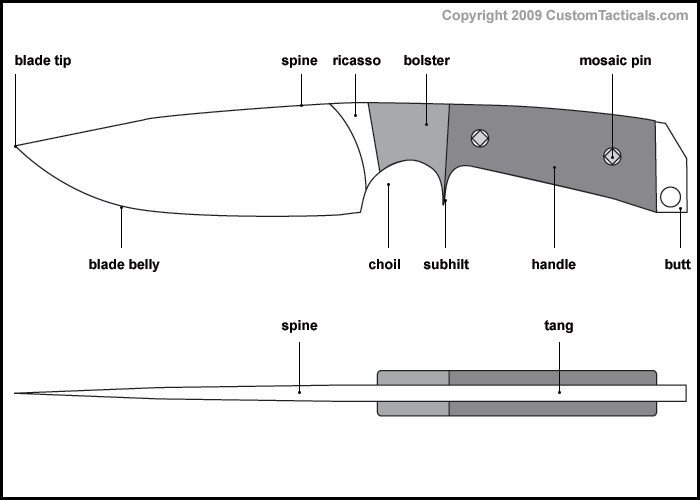Anatomy of a Fixed Blade Knife
Fixed Blade Knife Anatomy

Legend
Not all of these features will always be present on a fixed blade knife, and conversely, there are features that some knives will have that are not illustrated here. The picture above is just one example. Please see the folding knife anatomy page for some more knife anatomy information that may apply to fixed blades.
Blade Tip - Pretty self-explanatory. The tip or point of the blade.
Spine - The back, usually unsharpened side of the blade.
Ricasso - The ricasso is the unbevelled portion of the blade after the blade grind where the blade meets the handle. Usually a maker's mark can be found here.
Bolster - A portion of the handle that beings immediately after the ricasso. On a fixed blade knife, the bolster serves to balance the knife more than strengthen it, such as on a folder. This balance is often important as with large knives, the blade-end can be very heavy.
Mosaic Pin - Pins are used to hold the handle scales in place, though scales are usually held with epoxy or glue as well. Mosaic pins are often used with hunters or fancier knives and have a pattern on them due to the different types of tubes and bars used to construct them.
Blade Belly - The belly is the curved part of the blade that begins after the tip. The belly of the blade improves its slicing ability because it is inherently ever-changing the angle applied to the object being sliced.
Choil - This is where your forefinger goes, and allows you to choke up on a knife for close up work. A choil can also be a smaller section at the end of the sharpened blade such as in the folder diagram, and may not be large enough for you to put your finger in.
Handle - The handle is pretty self-explanatory, but consists of the largest part of the handle, separate from the bolster. When I refer to 'handle material', this is the portion that I am talking about.
Butt - This is the rear end of the knife, where the lanyard hole is located. Depending on the construction of the knife this may be a pommel or a rear bolster or just an exposed tang as in the example above.
Tang - On a fixed blade the tang is the portion of the blade that is hidden inside the handle or sandwiched between the handle slabs, depending on the type of tang. There are four types of tang: Full Tang, Partial Tang, Tapered Tang and Hidden/Rat Tail Tang.